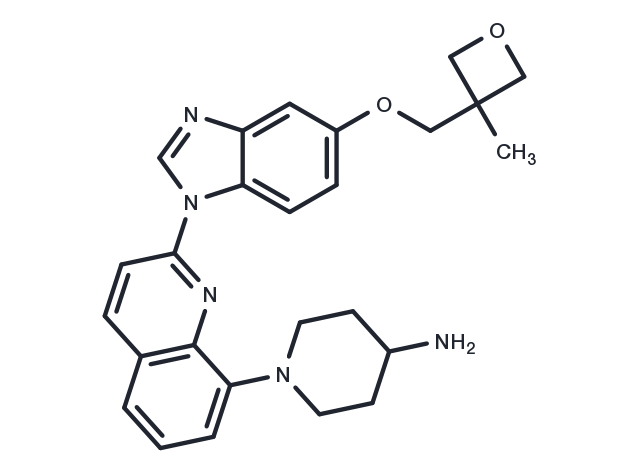Powder: -20°C for 3 years | In solvent: -80°C for 1 year
Crenolanib (ARO 002) is an orally bioavailable type III tyrosine kinases inhibitor of PDGFRα/β and FLT3 (IC50s: 11, 3.2, and 4 nM).

| パッケージサイズ | 在庫状況 | 単価(税別) | |||
|---|---|---|---|---|---|
| サンプルについてお問い合わせ | |||||
| 2 mg | 在庫あり | ¥ 12,500 | |||
| 5 mg | 在庫あり | ¥ 19,000 | |||
| 10 mg | 在庫あり | ¥ 30,500 | |||
| 25 mg | 在庫あり | ¥ 45,500 | |||
| 50 mg | 在庫あり | ¥ 65,000 | |||
| 100 mg | 在庫あり | ¥ 107,500 | |||
| 1 mL * 10 mM (in DMSO) | 在庫あり | ¥ 21,000 | |||
| 説明 | Crenolanib (ARO 002) is an orally bioavailable type III tyrosine kinases inhibitor of PDGFRα/β and FLT3 (IC50s: 11, 3.2, and 4 nM). |
| ターゲット&IC50 | FLT3:0.74 nmol/L (Kd), PDGFRβ:2.1 nmol/L (Kd), PDGFRα:3.2 nmol/L (Kd) |
| In vitro | Crenolanib is a specific and potent inhibitor of RTK. The Kd of crenolanib for the wild-type receptors PDGFRA, PDGFRB, and FLT3 was 3.2, 2.1, and 0.74 nmol/L, respectively. In EOL-1 cell line, Crenolanib potently inhibits the kinase activity of the fusion oncogene with IC50 values of 21 nmol/L. In addition, it potently inhibits the proliferation of EOL-1 cells (IC50: 0.2 pmol/L) [1]. Crenolanib is a substrate of ABCB1, as evidenced by approximate five-fold resistance of ABCB1-overexpressing cells to crenolanib, reversal of this resistance by the ABCB1-specific inhibitor PSC-833 and stimulation of ABCB1 ATPase activity by crenolanib. In contrast, crenolanib was not a substrate of ABCG2 or ABCC1. Finally, incubation of the FLT3-ITD AML cell lines MV4-11 and MOLM-14 with crenolanib at a pharmacologically relevant concentration of 500 nM did not induce upregulation of ABCB1 cell surface expression [2]. Crenolanib treatment abolished phosphorylation of FLT3 and ERK in HB119 cells, as well as in the AML-patient–derived FLT3–ITD+ cell line Molm14. Fifty nanomolar crenolanib suppressed phosphorylation of FLT3 in primary isolates, including in leukemic blasts from a quizartinib-resistant patient whose disease had evolved an FLT3–ITD/D835Y mutation [3]. |
| In vivo | Crenolanib significantly inhibited the growth of tumor mass, and the strongest inhibitory effect was observed with 20 mg/kg treatment. Crenolanib induced massive apoptosis in tumor cells. Furthermore, the dosage of crenolanib applied was well tolerated by recipient mice. No weight loss was observed during the course of treatment [4]. Correlative data from an ongoing clinical trial demonstrate that acute myeloid leukemia patients can achieve sufficient levels of crenolanib to inhibit both FLT3/ITD and resistance-conferring FLT3/D835 mutants in vivo [5]. |
| キナーゼ試験 | Chinese hamster ovary (CHO) cells were transiently transfected with mutated KIT or PDGFRA cDNA constructs and treated with various concentrations of imatinib or crenolanib as previously described. Experiments involving recombinant DNA were carried out using biosafety level 2 conditions in accordance with published guidelines. Protein lysates from cell lines were prepared and subjected to immunoprecipitation using anti-KIT or anti-PDGFRA antibodies followed by sequential immunoblotting for phospho-KIT and total KIT, or phosphotyrosine or total PDGFRA, respectively, as previously reported. Densitometry was carried out to quantify drug effect using Photoshop 5.1 software, with the level of phospho-KIT or phospho-PDGFRA normalized to total protein. Densitometry and proliferation experimental results were analyzed using Calcusyn 2.1 software to mathematically determine the IC50 values. The Wilcoxon rank sum test was used to compare the IC50 values of imatinib and crenolanib for a given mutation [1]. |
| 細胞研究 | Cells were added to 96-well plates at densities of 20,000 cells per well and incubated with imatinib or crenolanib for 72 hours before measuring cellular proliferation using a 2,3-bis[2-methoxyl-4-nitro-5-sulfophenyl]-2H-tetrazolium-5-carboxanilide (XTT)–based assay [1]. |
| 動物実験 | A549 cells were injected into the axillary regions of mice (2×10^6 cells/mouse). When the tumor volumes reached 70 mm^3, the mice were randomly allocated to the control group, low-dose crenolanib group (10 mg/kg), or high-dose crenolanib group (20 mg/kg) (n=6 per group). The vehicle for crenolanib treatment consists of 10% 1-methyl-2-pyrrolidinone and 90% polyethylene glycol 300. The tumor size and mouse body weight were measured every other day for about 2 weeks. The tumor volume was calculated as follows: (mm^3) = (width × width × length)/2. After treatment, the mice were euthanized using carbon dioxide, and the tumors were harvested and analyzed [4]. |
| 別名 | ARO 002, CP-868596 |
| 分子量 | 443.54 |
| 分子式 | C26H29N5O2 |
| CAS No. | 670220-88-9 |
Powder: -20°C for 3 years | In solvent: -80°C for 1 year
DMSO: 89 mg/mL (200.65 mM), Heating is recommended.
Ethanol: 7 mg/mL (15.78 mM)
You can also refer to dose conversion for different animals. 詳細
bottom
Please see Inhibitor Handling Instructions for more frequently ask questions. Topics include: how to prepare stock solutions, how to store products, and cautions on cell-based assays & animal experiments, etc.
Crenolanib 670220-88-9 Angiogenesis Autophagy Tyrosine Kinase/Adaptors FLT PDGFR Inhibitor FLT3 Platelet-derived growth factor receptor CD135 ARO002 ARO 002 CP868596 CP 868596 Cluster of differentiation antigen 135 CP-868596 inhibit Fms like tyrosine kinase 3 ARO-002 inhibitor
